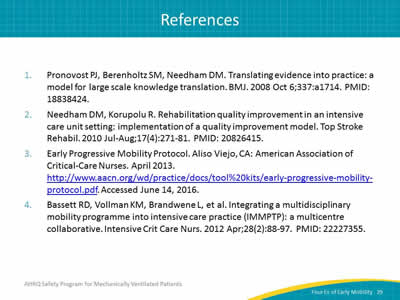The Four Es of Early Mobility: Facilitator Guide
AHRQ Safety Program for Mechanically Ventilated Patients
Slide 1: The Four Es of Early Mobility
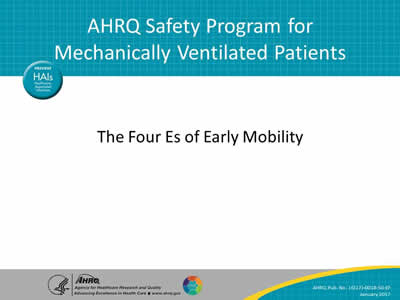
Say:
This module explains how to apply the Four Es of the TRIP framework to Early Mobility: engage, educate, execute, and evaluate.
Slide 2: Learning Objectives
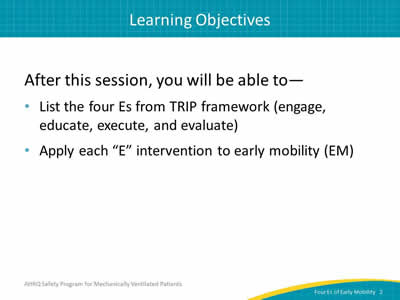
Say:
After this session, you will be able to name the Four Es from the Translating Research Into Practice (TRIP) model and apply each "E" intervention to early mobility in your unit.
Slide 3: Translating Research Into Practice
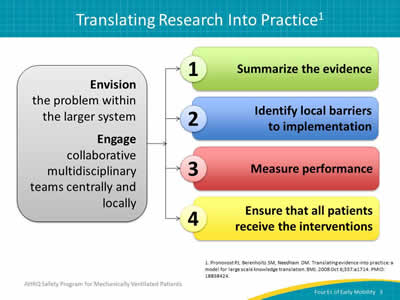
Say:
This diagram depicts the four steps in the TRIP model. Step one, summarizing the evidence. Step two, identify local barriers to implementation. Step three, measure your baseline performance. The final and most important step of the TRIP model is to ensure that all of your patients receive the interventions for early mobility every day. As you carry out these four steps, envision the problem within the larger system. Engage collaborative multidisciplinary teams both centrally and locally. This will require buy-in and engagement from your unit's entire care team and all stakeholders.
Slide 4: Summarize the Evidence
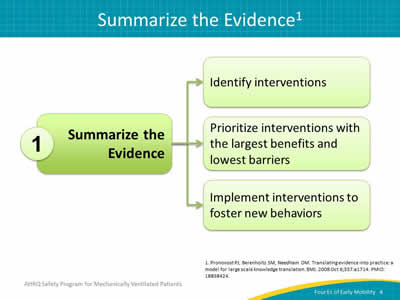
Say:
Again, the first step is to summarize the evidence: identify the key interventions and prioritize the interventions with the greatest benefit and smallest barriers. Then implement the interventions to foster new behaviors. Use a multidisciplinary, coordinated approach involving all members of your team including nurses, respiratory therapists, physicians, and physical and occupational therapists.
Slide 5: Identify Local Barriers
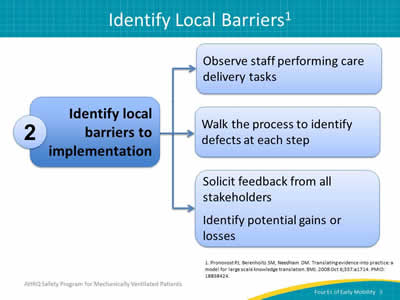
Say:
The next step in the TRIP model is identifying local barriers to implementation. Observe staff performing care delivery tasks. Walk through your current process to identify barriers at each step. What are the barriers or defects preventing the implementation of the different components of the ABCDEF bundle? For example, if a unit doesn’t have a pain scale beyond self-reporting, pain could be inadequately identified and/or managed. Another example may be that an order set for continuous sedation has a Richmond Agitation Sedation Scale or RASS target of -2 or no target at all. Because of this, staff believe the increase in workload to mobilize patients will prevent them from getting patients up and moving. Solicit feedback from all stakeholders and identify potential gains or losses.
Slide 6: What Are Your Barriers?
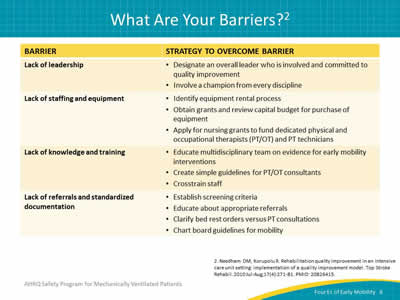
Say:
One example of a barrier to implementation of early mobility interventions is lack of leadership. To overcome this obstacle, designate an overall leader who is involved and committed to quality improvement. Involve a champion from every discipline. Another barrier might be a lack of staffing or equipment. Some strategies to combat these barriers would be to identify the equipment rental process, obtain grants and review capital budget for purchase of equipment, and apply for grants to fund dedicated physical and occupational therapists (PT/OT) and PT technicians. Another common barrier is a lack of knowledge and training. To overcome this obstacle to implementation, educate your multidisciplinary team on evidence for early mobility interventions. This will also help to achieve greater cooperation and buy-in. Cross-train your staff and create simple guidelines for PT/OT consultants. Lack of referrals and standardized documentation is an obstacle which can be overcome with these strategies: establish screening criteria, educate about appropriate referrals, clarify bed rest orders versus PT consultations, and chart board guidelines for mobility.
Slide 7: What Are Your Barriers?
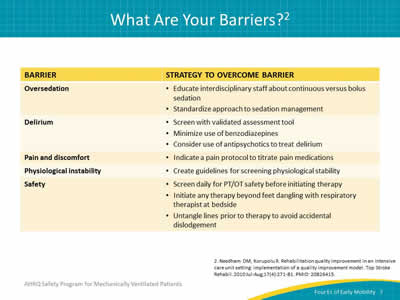
Say:
Perceived patient barriers to early mobility include oversedation and delirium. It is therefore important to educate your interdisciplinary staff about continuous versus bolus sedation and to standardize your approach to sedation management. Also educate your staff that delirium itself is not a contraindication to mobility, and that early mobility can actually reduce duration of delirium. Minimize the use of benzodiazepines, screen with a validated assessment tool, and encourage the use of antipsychotics. To lesson pain, discomfort, and physiological instability to the patient, indicate a pain protocol to titrate pain medications, and create guidelines for screening for physiological instability. Finally, to ensure that it is safe for a patient to be mobilized, screen daily for PT/OT safety before initiating therapy. Initiate any therapy beyond feet dangling with the respiratory therapist at the patient’s bedside and untangle lines prior to therapy to avoid accidental dislodgement.
Slide 8: Measure Performance
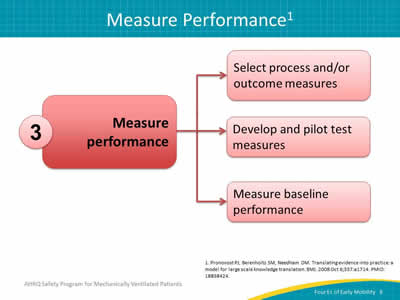
Say:
The third step in the TRIP framework is to measure performance. Once the process and/or outcome measures have been selected and pilot tested, define a data collection process at your organization. Then you may begin to collect data and measure baseline performance.
Slide 9: Ensure All Patients Receive the Evidence (Four Es)
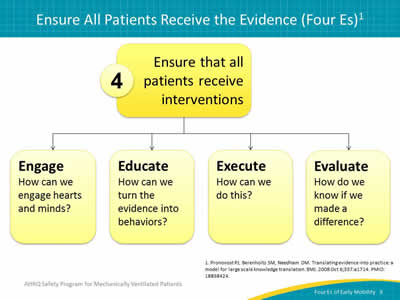
Say:
The fourth and final step of the TRIP model is to ensure that all patients receive the early mobility interventions. As you think of the Four Es—engage, educate, execute, and evaluate—ask these questions: How can we engage the hearts and minds of our team members? How can we educate our staff so that we can turn the evidence into behaviors? How can execute our plan and make this happen? Finally, how do we know if we made a difference in the lives of our patients?
Slide 10: Four Es of Early Mobility
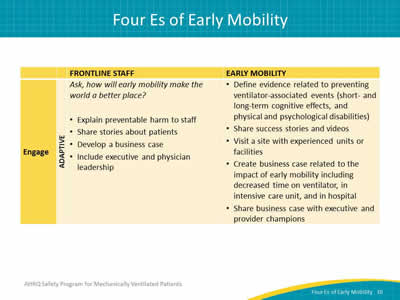
Say:
The first E of the Four Es of early mobility is engage. Begin to engage your frontline staff by asking them how their contributions to the early mobilization of patients will have a positive impact on individual lives and will make the world a better place. Changing the attitudes and behaviors of the frontline staff is the adaptive component of early mobility. Explain what preventable harm means and share success stories about how patient harms were prevented. Define the evidence related to preventing ventilator-associated events, including short- and long-term cognitive effects and physical and psychological disabilities. Create a business case related to the impact of early mobility, including increased time off the ventilator and decreased hospital and intensive care unit or ICU length of stay. Sharing the business case with executive and physician champions will help to engage them in the early mobility process.
Slide 11: Four Es of Early Mobility
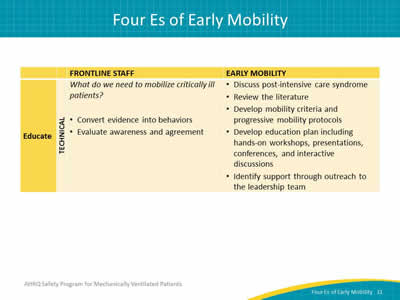
Say:
The second E is education. This involves educating the frontline staff and all providers on how to go about mobilizing patients. It is not enough to know that early mobility is important. Evaluating clinicians’ awareness of the necessary steps to early mobility and reaching agreements on how early mobility will be carried out, along with converting evidence into practice, is the technical component of early mobility. This is done by: discussing post-intensive care syndrome, reviewing the literature, developing mobility criteria and progressive mobility protocols, developing an education plan including hands-on workshops, presentations, conferences, and interactive discussions, and identifying support through outreach to the leadership team. Establish nurse-driven screening and mobilization protocols. Educate your providers, either formally through lectures and demonstrations or informally at the bedside. Mobilizing patients is challenging. A solid infrastructure needs to be in place to reliably and safely deliver the early mobility interventions to your patients. You cannot just decide in the morning during rounds to mobilize a mechanically ventilated patient. Early mobility requires the coordination and collaboration of a multidisciplinary team and established known processes to ensure success.
Slide 12: Four Es of Early Mobility
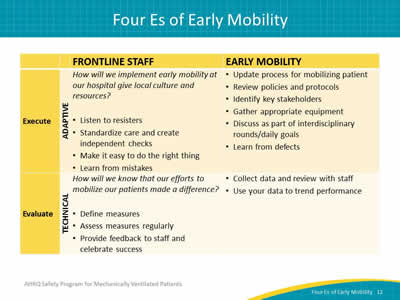
Say:
The third E is execute. Ask the question, "How will we implement early mobility at our hospital, change the culture, and provide the necessary resources to make it happen?" Listen to your resisters. Make it easy to do the right thing. Learn from your mistakes. Standardize care and create independent checks. The execute step will help to improve the culture of safety in your unit. The early mobilization of your patients will require that you review policies and protocols that you currently have in place and make any necessary changes. Update your process for mobilizing patients as you identify your key stakeholders. Discuss early mobility and your mobility goals for each patient during your interdisciplinary rounds. Learn from your defects. A defect is anything you do not want to happen again. Ask, "What happened and why did it happen?" "How do we reduce the likelihood of the defect happening again?" "How will we know the risk has been reduced?" Employ a systematic process to learn from your mistakes.
The last E is evaluate. How will you know that your efforts to mobilize your patients made a difference? Evaluate your technical measures. Define and then assess your process and outcomes measures regularly. Collect data and share your performance results with your staff. Performance data and trends can be posted on your unit’s bulletin board or shared by email or in staff meetings. Use whatever method you think will be helpful to provide feedback to your staff.
Slide 13: Engage and Educate Frequently
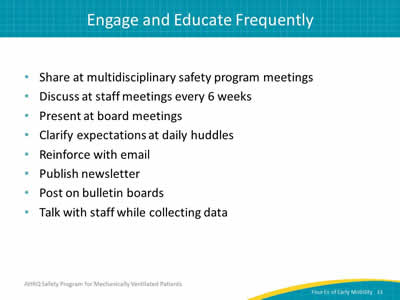
Say:
Engage and educate your staff at every opportunity and as frequently as possible. Discuss process and outcome measures, early mobility successes, and barriers to implementation at multidisciplinary safety program meetings and at staff and board meetings. Clarify expectations during daily huddles. Sending emails, posting on bulletin boards, publishing in your newsletter, and talking with your staff while data are being collected are all opportunities to engage and educate your staff. Be sure to celebrate your successes which will inspire and improve teamwork and collaboration.
Slide 14: Engage All Staff
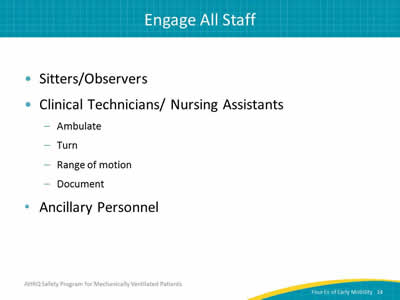
Ask:
Who in particular should we engage?
Say:
In addition to the obvious players—nurses, physicians, and respiratory, physical, and occupational therapists—we also need to engage sitters or observers, clinical technicians, and nursing assistants. They can help with ambulation and turning patients, range of motion exercises, and documentation. We also need to engage the patients’ family members. They want to be actively engaged and empowered to participate in the care of their loved ones.
Slide 15: Engage—Family Resources
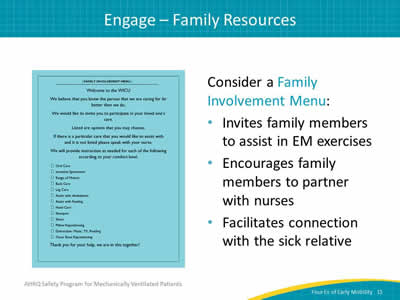
Say:
This is the Family Involvement Menu that has been used in the Weinberg ICU at Johns Hopkins Hospital to help engage family members in patient care. Family members can partner with nurses to participate in the general care of their loved one and assist with early mobility exercises. Consider creating your own family involvement menu to give families opportunities to be actively involved in the care of the patient.
Slide 16: Educate: Turn Evidence Into Behaviors
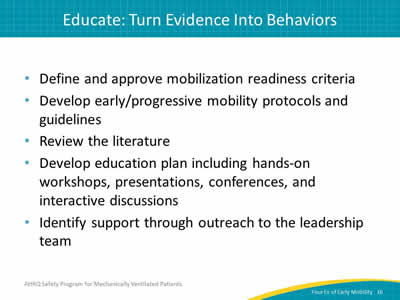
Say:
As part of the education process of implementing early mobility, evidence can be turned into behaviors by doing the following: define and approve mobilization readiness criteria, develop early mobility protocols and guidelines, review the literature, develop an education plan including hands-on workshops, presentations, conferences, and interactive discussions, and identify support through outreach to the leadership team.
Slide 17: Readiness Assessment: Other Considerations
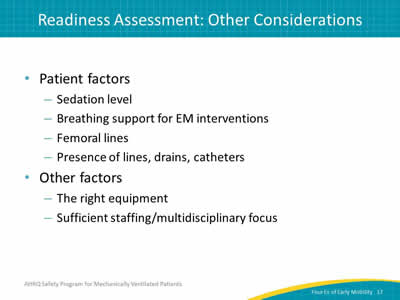
Say:
Because various factors need to be taken into consideration before a patient can be mobilized, it is necessary to administer a readiness assessment. Patient factors consist of the following: sedation level, breathing support for early mobility intervention, femoral lines, and the presence of lines, drains, and catheters. Having the correct equipment and sufficient staffing with a multidisciplinary focus are additional factors which should be considered for early mobility.
Slide 18: Execute: Make It Easy To Do the Right Thing
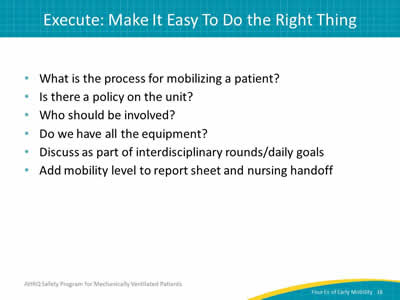
Say:
Facilitate mobilizing the patient by making it easy to do the right thing. Address these questions: What is the process for mobilizing a patient? Is there a policy on the unit? Who should be involved in the early mobility process, and do we have the necessary equipment in the unit to mobilize the patient? In addition, discuss daily goals for early mobility for each patient during interdisciplinary rounds. Be sure to add the patient’s mobility level to the report sheet and nursing handoff.
Slide 19: Early Progressive Mobility Protocol
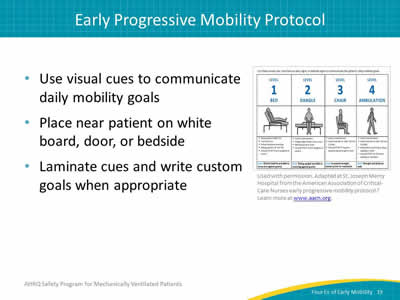
Say:
On the right side of this slide, you will see an example of a visual cue that can be used to communicate daily mobility goals. The four levels of mobility are illustrated: sitting up in bed, dangling the legs over the bed, sitting in a chair, and ambulation. This visual aid can be laminated and placed in the patient’s room on the white board, at the bedside, or on the door to be seen by staff and family. Be sure to customize mobility goals for the patient when appropriate.
Slide 20: Sample Early Mobility Protocol
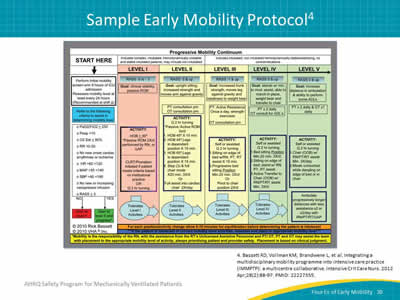
Say:
A progressive patient mobility guideline is used to facilitate and standardize mobility for all patients. Ensure that appropriate activity orders are obtained and that there is excellent communication between all members of your interdisciplinary team before attempting early mobilization of your patients.
Here is a sample of an early mobility protocol which can be used for intubated and nonintubated patients. It illustrates a progressive mobility continuum for complex, intubated, hemodynamically unstable, and stable intubated patients, with and without contraindications. Start by performing an initial mobility screen within 8 hours of ICU admission and reassess the patient mobility level every shift change or at least every 24 hours. If a patient is intolerant of the current mobility level activities, reassess and place in the appropriate mobility level.
Slide 21: Evaluate: Measure Your Success
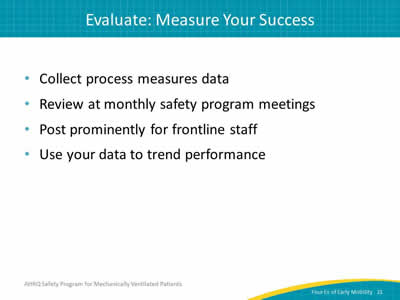
Say:
During the evaluation phase, which is the fourth and final E of the TRIP model, collect process measure data and review your performance results at monthly safety program meetings. Use the data to trend performance data, post-performance data, and trends in prominent locations so as to be available to all members of your team. This evaluation will enable staff to see the areas where they have been successful as well as what areas need to be improved.
Slide 22: Daily Early Mobility Measures Form
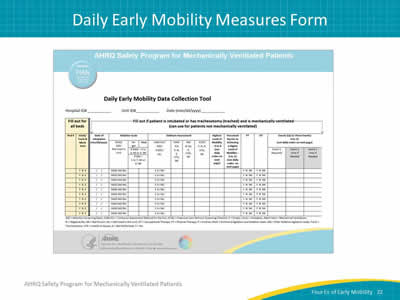
Say:
The Daily Early Mobility Measures form will help you track your compliance with each of the measures which will assist you in the implementation of early mobility. This tool will enable you to track your management of sedation and delirium levels, your perceived barriers to mobilizing your patients, the involvement of physical and occupational therapy in mobilizing your patients, and any events which may occur during the mobilization process.
Slide 23: Daily Early Mobility Measures Guide
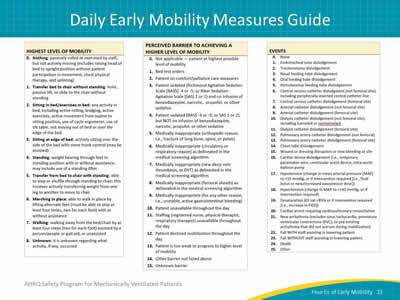
Say:
Here are the lists of three categories of Daily Data Collection Tool Codes: highest level of mobility, perceived barriers to achieving a higher level of mobility, and events. Refer to these codes when completing the Daily Early Mobility Measures Form.
Slide 24: Highest Level of Mobility
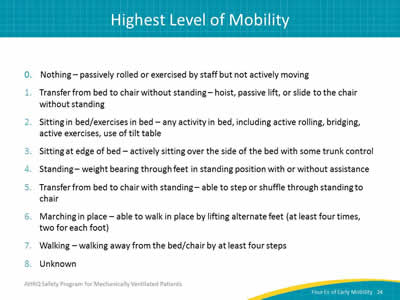
Say:
These are the codes used for measuring mobility, beginning with 0 to indicate no active mobilization to 7 to indicate ambulation from the bed or chair by at least four steps. If the person entering the data is not certain of what level of mobility was implemented, number 8, "Unknown," would be indicated.
Slide 25: Perceived Barriers
![0. Not applicable - patient at highest possible level of mobility. 1. Bed rest orders. 2. Patient on comfort/palliative care measures. 3. Patient sedated (Richmond Agitation-Sedation Score [RASS] -4 or -5; or Riker Sedation-Agitation Scale [SAS] 1 or 2) and on infusion of benzodiazepine, narcotic, or propofol. 4. Patient sedated (RASS -4 or -5; or SAS 1 or 2), but NOT on infusion of benzodiazepine, narcotic, or propofol. 5. Medically inappropriate (orthopedic reason, e.g., fracture of long bone, spine, or pelvis). 6. Medically inappropriate (circulatory or respiratory reason) as delineated in the medical screening algorithm.](/sites/default/files/wysiwyg/professionals/quality-patient-safety/hais/tools/mvp/modules/technical/4es/4es-early-mobility-slide25.jpg)
Say:
The codes for perceived barriers are listed here. If the patient is already at the highest level of mobility, enter "0" to indicate not applicable. The other numbers are as follows: 1 – bed rest orders, 2 – patient on comfort/palliative care measures, 3 – patient sedated and on infusion of benzodiazepine, narcotic, or propofol, 4 – patient sedated but not on infusion of benzodiazepine, narcotic, or propofol, 5 – medically inappropriate for orthopedic reasons, and 6 – medically inappropriate as delineated in the medical screening algorithm for circulatory or respiratory reasons.
Slide 26: Perceived Barriers
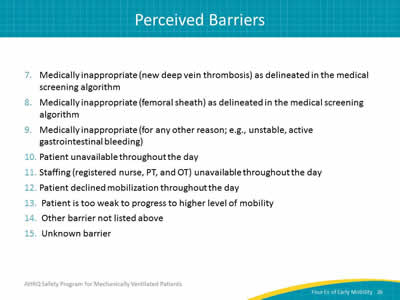
Say:
The rest of the nine perceived barriers to mobility are: 7 – medically inappropriate due to a new deep vein thrombosis as delineated in the medical screening algorithm, 8 – medically inappropriate due to femoral sheath as delineated in the medical screening algorithm, and 9 – medically inappropriate for any other reason. Other barriers include: patient or staff unavailable throughout the day, patient declined mobilization throughout the day, patient too weak to progress to a higher level of mobility, other barrier not listed, and unknown barrier.
Slide 27: Adverse Events During Mobilization
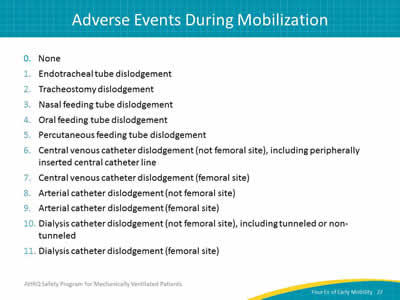
Say:
The codes for events are listed here: none, endotracheal tube dislodgement, tracheostomy dislodgement, nasal or oral feeding tube dislodgement, percutaneous feeding tube dislodgement, femoral and nonfemoral site central venous, arterial, and dialysis catheter dislodgement.
Slide 28: Summary
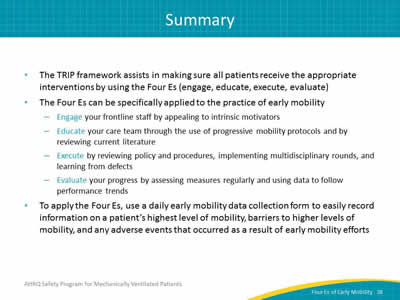
Ask:
What have we learned today about the Four Es of early mobility?
Say:
First, the TRIP framework assists in making sure all patients receive the appropriate interventions by using the Four Es (engage, educate, execute, evaluate). Second, the Four Es can be specifically applied to the practice of early mobility through engaging your frontline staff by appealing to intrinsic motivators, educating your care team through the use of progressive mobility protocols, and reviewing current literature. Early mobility efforts can also be executed by reviewing policy and procedures, implementing multidisciplinary rounds, learning from defects, and evaluating your progress by assessing measures regularly and using data to follow performance trends. Finally, in order to capture the information you will need to apply the Four Es, use a daily early mobility data collection form to easily record information on a patient’s highest level of mobility, barriers to higher levels of mobility, and any adverse events that occurred as a result of early mobility efforts.
Slide 29: References
